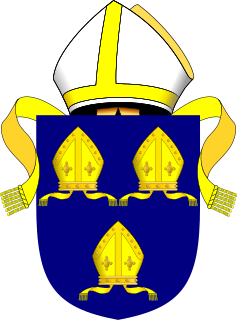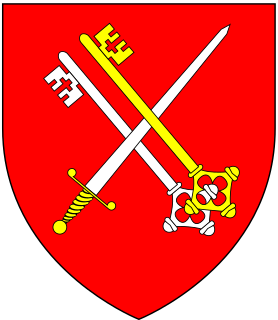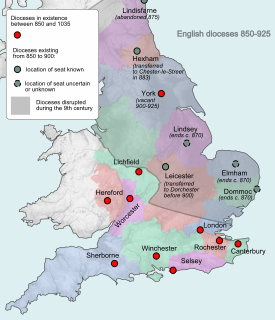Related Research Articles
Waldric was the eighth Lord Chancellor and Lord Keeper of England, from 1103 to 1107. He was also Bishop of Laon from 1106 to 1112. He had been a royal chaplain as early as 3 September 1101.
William FitzGilbert was the fifteenth Lord Chancellor of England, from 1141 to 1142, serving the Empress Matilda.
Richard le Gras was Lord Keeper of England and Abbot of Evesham in the 13th century.

The Bishop of Norwich is the ordinary of the Church of England Diocese of Norwich in the Province of Canterbury. The diocese covers most of the county of Norfolk and part of Suffolk. The bishop of Norwich is Graham Usher.

The Archbishop of York is a senior bishop in the Church of England, second only to the archbishop of Canterbury. The archbishop is the diocesan bishop of the Diocese of York and the metropolitan bishop of the Province of York, which covers the northern regions of England as well as the Isle of Man. The archbishop of York is an ex officio member of the House of Lords and is styled Primate of England; the archbishop of Canterbury is the Primate of All England.
Sir Robert Parning was an English lawyer and administrator.

The Bishop of Winchester is the diocesan bishop of the Diocese of Winchester in the Church of England. The bishop's seat (cathedra) is at Winchester Cathedral in Hampshire. The Bishop of Winchester holds ex officio the office of Prelate of the Most Noble Order of the Garter since its foundation in 1348, and Bishops of Winchester often held the positions of Lord Treasurer and Lord Chancellor ex officio. During the Middle Ages, it was one of the wealthiest English sees, and its bishops have included a number of politically prominent Englishmen, notably the 9th century Saint Swithun and medieval magnates including William of Wykeham and Henry of Blois.
Æthelric was Bishop of Durham from 1041 to 1056 when he resigned.
Ætla, who lived in the 7th century, is believed to be one of many Bishops of Dorchester during the Anglo-Saxon period. The village of Attlebridge, Norfolk is named after him, as he is credited for the construction of a bridge there.
Eardwulf was a medieval Bishop of Dunwich.
Aethelweald was a medieval Bishop of Elmham.
William de Beaufeu was a medieval Bishop of Thetford and a major landholder mentioned in the Domesday Book.
Eadmund was a 9th-century Englishman. It had been thought he had been Bishop of Winchester between 833 and 838. However, following further studies he is no longer listed to have been bishop.
William Hamilton was deputy chancellor of England from 1286 to 1289, then Lord Chancellor from 1305 to his death on 20 April 1307. He was also Dean of York.
John Scarle was keeper of the rolls of Chancery from 1394 to 1397 and Archdeacon of Lincoln before being named Lord Chancellor of England in 1399. He held that office until 9 March 1401. He was also Clerk of the Parliament between November 1384 and February 1397.
Wulfsige was a medieval Bishop of Cornwall.
Æthelred was a medieval Bishop of Cornwall.
Cuthwine was a medieval Bishop of Leicester.

The Bishop of Dunwich is an episcopal title which was first used by an Anglo-Saxon bishop between the seventh and ninth centuries and is currently used by the suffragan bishop of the Diocese of St Edmundsbury and Ipswich. The title takes its name after Dunwich in the English county of Suffolk, which has now largely been lost to the sea.
The Bishop of Ramsbury was an episcopal title used by medieval English-Catholic diocesan bishops in the Anglo-Saxon English church. The title takes its name from the village of Ramsbury in Wiltshire, and was first used in the 10th and 11th centuries by the Anglo-Saxon Bishops of Ramsbury. In Saxon times, Ramsbury was an important location for the Church, and several of the early bishops went on to become Archbishops of Canterbury.
References
- Powicke, F. Maurice and E. B. Fryde Handbook of British Chronology 2nd. ed. London:Royal Historical Society 1961